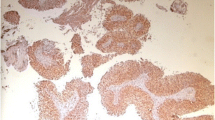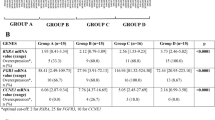Abstract
The fibroblast growth factor receptor 3 (FGFR3) is a tyrosine kinase receptor frequently activated by point mutations in bladder cancer (BC). These mutations are associated with genetically stable, Ta and low-grade BC, representing the favourable BC pathway. Conversely, FGFR3 over-expression was recently found in 40 % of muscle invasive BC. We examined FGFR3 mutation status and protein expression in patients originally diagnosed as T1. We also investigated copy-number variations in FGFR3 as a possible alternative mechanism to activate FGFR3. We included 84 patients with T1 BC as their initial diagnosis. A uropathologist reviewed the slides for grade and (sub)stage. The FGFR3 mutation status was examined by PCR-SNaPshot and FGFR3 protein expression by standard immuno-histochemistry (FGFR3-B9). Copy-number status was determined in 69/84 cases with nine probes covering nine exons of the FGFR3 gene (MLPA). Of 27 BC with FGFR3 mutations, 26 (96 %) showed FGFR3 over-expression. Of the 57 wild-type BC, 27 (47 %) BC showed over-expression. Pathological parameters significantly differed (p < 0.01) between mutant and wild-type tumours with the FGFR3 mutation pointing to more favourable BC. However, if the BC exhibited wild-type FGFR3, FGFR3 protein status had no influence on grade and (sub)stage. We found six tumours with more than or equal to three copies of FGFR3. Only 1 of 22 wild-type tumours with over-expression of FGFR3 had more than or equal to three gene copies. In initially diagnosed T1 BC, only the FGFR3 mutation was significantly associated with favourable BC disease characteristics. In addition to almost all FGFR3 mutant BC, 47 % of wild-type BC displayed FGFR3 over-expression, suggesting an alternative mechanism to activate FGFR3. Increased FGFR3 copy number was a rare event and did not account for this mechanism. Nevertheless, FGFR3 wild-type tumours with over-expression of the protein may still represent a subset that might potentially benefit from FGFR3-targeted therapy.




Similar content being viewed by others
References
Siegel R, Naishadham D, Jemal A (2013) Cancer statistics. CA Cancer J Clin 63:11–30. doi:10.3322/caac.21166
Sylvester RJ, van der Meijden AP, Oosterlinck W, Witjes JA, Bouffioux C, Denis L, Newling DW, Kurth K (2006) Predicting recurrence and progression in individual patients with stage Ta T1 bladder cancer using EORTC risk tables: a combined analysis of 2596 patients from seven EORTC trials. Eur Urol 49:466–475
van Rhijn BW, Vis AN, van der Kwast TH, Kirkels WJ, Radvanyi F, Ooms EC, Chopin DK, Boevé ER, Jöbsis AC, Zwarthoff EC (2003) Molecular grading of urothelial cell carcinoma with fibroblast growth factor receptor 3 and MIB-1 is superior to pathologic grade for the prediction of clinical outcome. J Clin Oncol 21:1912–1921
di Martino E, Tomlinson DC, Knowles MA (2012) A decade of FGF receptor research in bladder cancer: past, present, and future challenges. Adv Urol 2012:429213. doi:10.1155/2012/429213
van Rhijn BW, van der Kwast TH, Vis AN, Kirkels WJ, Boevé ER, Jöbsis AC, Zwarthoff EC (2004) FGFR3 and P53 characterize alternative genetic pathways in the pathogenesis of urothelial cell carcinoma. Cancer Res 64:1911–1914
Hernández S, López-Knowles E, Lloreta J, Kogevinas M, Amorós A, Tardón A, Carrato A, Serra C, Malats N, Real FX (2006) Prospective study of FGFR3 mutations as a prognostic factor in nonmuscle invasive urothelial bladder carcinomas. J Clin Oncol 24:3664–3671
Mhawech-Fauceglia P, Fischer G, Alvarez V Jr, Ahmed A, Herrmann FR (2007) Predicting outcome in minimally invasive (T1a and T1b) urothelial bladder carcinoma using a panel of biomarkers: a high throughput tissue microarray analysis. BJU Int 100:1182–1187
Barbisan F, Santinelli A, Mazzucchelli R, Lopez-Beltran A, Cheng L, Scarpelli M, van der Kwast T, Montironi R (2008) Strong immunohistochemical expression of fibroblast growth factor receptor 3, superficial staining pattern of cytokeratin 20, and low proliferative activity define those papillary urothelial neoplasms of low malignant potential that do not recur. Cancer 112:636–644
Matsumoto M, Ohtsuki Y, Ochii K, Seike Y, Iseda N, Sasaki T, Okada Y, Kurabayashi A, Furihata M (2004) Fibroblast growth factor receptor 3 protein expression in urothelial carcinoma of the urinary bladder, exhibiting no association with low-grade and/or non-invasive lesions. Oncol Rep 12:967–971
Tomlinson DC, Baldo O, Harnden P, Knowles MA (2007) FGFR3 protein expression and its relationship to mutation status and prognostic variables in bladder cancer. J Pathol 213:91–98
Bodoor K, Ghabkari A, Jaradat Z, Alkhateeb A, Jaradat S, Al-Ghazo MA, Matalka I, Musleh H, Haddad Y (2010) FGFR3 mutational status and protein expression in patients with bladder cancer in a Jordanian population. Cancer Epidemiol 34:724–732
van Oers JM, Lurkin I, van Exsel AJ, Nijsen Y, van Rhijn BW, van der Aa MN, Zwarthoff EC (2005) A simple and fast method for the simultaneous detection of nine fibroblast growth factor receptor 3 mutations in bladder cancer and voided urine. Clin Cancer Res 11:7743–7748
Otto W, Denzinger S, Bertz S, Gaumann A, Wild PJ, Hartmann A, Stoehr R (2009) No mutations of FGFR3 in normal urothelium in the vicinity of urothelial carcinoma of the bladder harbouring activating FGFR3 mutations in patients with bladder cancer. Int J Cancer 125:2205–2208
Billerey C, Chopin D, Aubriot-Lorton MH, Ricol D, Diez G, de Medina S, Van Rhijn B, Bralet MP, Lefrere-Belda MA, Lahaye JB, Abbou CC, Bonaventure J, Zafrani ES, van der Kwast T, Thiery JP, Radvanyi F (2001) Frequent FGFR3 mutations in papillary non-invasive bladder (pTa) tumors. Am J Pathol 158:1955–1959
Neuzillet Y, Paoletti X, Ouerhani S, Mongiat-Artus P, Soliman H, de The H, Sibony M, Denoux Y, Molinie V, Herault A, Lepage ML, Maille P, Renou A, Vordos D, Abbou CC, Bakkar A, Asselain B, Kourda N, El Gaaied A, Leroy K, Laplanche A, Benhamou S, Lebret T, Allory Y, Radvanyi F (2012) A meta-analysis of the relationship between FGFR3 and TP53 mutations in bladder cancer. PLoS One 7:e48993
Gómez-Román JJ, Saenz P, Molina M, Cuevas González J, Escuredo K, Santa Cruz S, Junquera C, Simón L, Martínez A, Gutiérrez Baños JL, López-Brea M, Esparza C, Val-Bernal JF (2005) Fibroblast growth factor receptor 3 is overexpressed in urinary tract carcinomas and modulates the neoplastic cell growth. Clin Cancer Res 11:459–465
Nord H, Segersten U, Sandgren J, Wester K, Busch C, Menzel U, Komorowski J, Dumanski JP, Malmström PU, Díaz de Ståhl T (2010) Focal amplifications are associated with high grade and recurrences in stage Ta bladder carcinoma. Int J Cancer 126:1390–1402
Knowles MA (2006) Molecular subtypes of bladder cancer: Jekyll and Hyde or chalk and cheese? Carcinogenesis 27:361–373
Wu XR (2005) Urothelial tumorigenesis: a tale of divergent pathways. Nat Rev Cancer 5:713–725
Vékony H, Ylstra B, Wilting SM, Meijer GA, van de Wiel MA, Leemans CR, van der Waal I, Bloemena E (2007) DNA copy-number gains at loci of growth factors and their receptors in salivary gland adenoid cystic carcinoma. Clin Cancer Res 13:3133–3139
Chesi M, Nardini E, Brents LA, Schröck E, Ried T, Kuehl WM, Bergsagel PL (1997) Frequent translocation t(4;14)(p16.3;q32.3) in multiple myeloma is associated with increased expression and activating mutations of fibroblast growth factor receptor 3. Nat Genet 16:260–264
Williams SV, Hurst CD, Knowles MA (2013) Oncogenic FGFR3 gene fusions in bladder cancer. Hum Mol Genet 22:795–803
Lindgren D, Liedberg F, Andersson A, Chebil G, Gudjonsson S, Borg A, Månsson W, Fioretos T, Höglund M (2006) Molecular characterization of early-stage bladder carcinomas by expression profiles, FGFR3 mutation status, and loss of 9q. Oncogene 25:2685–2696
Karkoulis PK, Stravopodis DJ, Konstantakou EG, Voutsinas GE (2013) Targeted inhibition of heat shock protein 90 disrupts multiple oncogenic signaling pathways, thus inducing cell cycle arrest and programmed cell death in human urinary bladder cancer cell lines. Cancer Cell Int 13:11
Liu GH, Zhong Q, Ye YL, Wang HB, Hu LJ, Qin ZK, Zeng MS, Zeng BH (2013) Expression of beclin 1 in bladder cancer and its clinical significance. Int J Biol Markers 28:56–62
Dolloff NG, Talamo G (2013) Targeted therapy of multiple myeloma. Adv Exp Med Biol 779:197–221
Bernard-Pierrot I, Brams A, Dunois-Lardé C, Caillault A, Diez de Medina SG, Cappellen D, Graff G, Thiery JP, Chopin D, Ricol D, Radvanyi F (2006) Oncogenic properties of the mutated forms of fibroblast growth factor receptor 3b. Carcinogenesis 27:740–747
Tomlinson DC, Hurst CD, Knowles MA (2007) Knockdown by shRNA identifies S249C mutant FGFR3 as a potential therapeutic target in bladder cancer. Oncogene 26:5889–5899
Acknowledgments
The authors would like to thank Simone Russell, Rati Vajpeyi, Sally Hanna, Roni Sambas and Cynthia Kuk for help and advice. The Regional Ethics Board of the University Health Network, Toronto (02-0515-C and 08-0263-T), gave approval. Financial support was given by the University of Toronto and by a grant from the Dutch Cancer Society – KWF Kankerbestrijding.
Conflict of interest
None
Author information
Authors and Affiliations
Corresponding author
Additional information
Yann Neuzillet, Bas W. G. van Rhijn and Nadia L. Prigoda contributed equally to this article
Rights and permissions
About this article
Cite this article
Neuzillet, Y., van Rhijn, B.W.G., Prigoda, N.L. et al. FGFR3 mutations, but not FGFR3 expression and FGFR3 copy-number variations, are associated with favourable non-muscle invasive bladder cancer. Virchows Arch 465, 207–213 (2014). https://doi.org/10.1007/s00428-014-1596-4
Received:
Revised:
Accepted:
Published:
Issue Date:
DOI: https://doi.org/10.1007/s00428-014-1596-4




